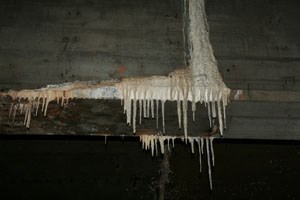
National Park Service
A conquest remembered George Rogers Clark and his small frontier army accepted the surrender of Fort Sackville on Feb. 25, 1779. This battle was an important milestone in America’s quest for independence. It also was the beginning of the new United States expansion into the western frontier.
As 1929 and the 150th anniversary of the surrender approached there was a growing desire to remember the deeds of Clark and his frontiersmen. Construction on the project would begin during 1931. By mid-1933 the monument was near completion.
The impressive structure rivaled even those in Washington D.C. It stood some 85 feet tall in all its majesty. This truly was a monument which could honor Clark’s deeds.
All was not well with the stone giant On March 26, 1934, within six weeks of the day the memorial building was accepted by the executive committee, the members were informed that following a rain there appeared: “numerous small leaks through the terrace into the finished rooms in the basement . . . (and) there were very heavy leaks around the downspouts at the corners of the terrace.”
By Jan. 30, 1937 leaks had become so numerous that a report stated, “the disastrous results” to the building were “appalling.”
During April 1939, an inspection of the structure described the situation and “decadent conditions . . . caused by leakage, which had been allowed to exist.” This inspection found stalactites four feet in length where water seeped through the structure.
This inspection also identified the cause of the seepage problem as “damage to (the) waterproof membrane.” This was caused when granite slabs were moved into place and the concrete of the terrace surface was poured. “Improperly designed terrace drains” also were cited as a contributing factor. The report concluded, “If money were no problem, the difficulty could be corrected by removal of all the granite slabs and pebble-concrete terrace pavement and replacement of the fractured waterproof membrane.”
No easy fix Money would however, be a problem. During the coming years, thousands of dollars were expended upon sealing joints and attempts to waterproof the surface of the terrace. Attempts to solve the problems were undertaken during 1941, 1943, 1952, 1958, 1965, 1973, 1978, and 1979. While some proved temporarily successful, none stopped the water seepage into the basement.
During 1998, the National Park Service was preparing for yet another waterproofing effort. The park staff at that time decided to forego the effort and, instead, seek funding for a permanent fix to the problem.
Finally - a solution The work currently being performed essentially is the same as that recommended in the 1939 inspection report. The concrete of the terrace is being removed to the level of the waterproof membrane. The membrane then will be replaced. The stone steps and outer walls will be removed and the walls and support system repaired or replaced. When the terrace surface is replaced, a new drain system will take the place of the original “improperly designed drains.”
When completed, the work will allow the monument to continue telling future generations about the heroic story of George Rogers Clark. |
Last updated: April 10, 2015
